Neonatal mortality and causes of death in Kersa Health and Demographic Surveillance System (Kersa HDSS), Ethiopia, 2008-2013
- PMID: 27437118
- PMCID: PMC4950756
- DOI: 10.1186/s40748-016-0035-8
Neonatal mortality and causes of death in Kersa Health and Demographic Surveillance System (Kersa HDSS), Ethiopia, 2008-2013
Abstract
Background: In the world, Neonatal mortality accounts for 40 % of death of children under the age of 5 years. Majority of neonatal deaths occur in developing countries outside of formal health system, among which death in the first hour of first day of their life constitute the huge bulk. This analysis is intended to estimate neonatal mortality rates and identify the leading causes of death based on the surveillance data over 6 years period in Kersa health and demographic surveillance system (Kersa HDSS) site, Eastern Ethiopia.
Methods: Kersa HDSS is an open dynamic cohort of population established in 2007. The surveillance started after conducting a baseline census followed by population update and events registration on house-to-house visits every 6 months. Data were collected using verbal autopsy (VA) questionnaire from close relatives (usually mothers in this case) and causes of deaths were assigned by 2 to 3 physicians. This analysis was done based on 301 neonatal deaths and 10,934 live births occurred during 2008 to 2013.
Results: The overall neonatal death rate during the study period was 27.5 per 1000 live births. Nearly all neonatal deaths (94 %) occurred at home. More than four-fifth (82.4 %) of the deaths was occurred in the first week of life. More than 80 % of the deaths were due to perinatal causes. Bacterial sepsis of the newborn accounted for 31.2 % followed by birth asphyxia and perinatal respiratory disorder (28.2 %), and prematurity (17.3 %). Higher number of death was observed in Tolla and Bereka sub-districts located at the southern parts of the study site which are away from the main road network.
Conclusion: The overall neonatal mortality over 6 years is the same to the national average (27 per 1000 live births). The leading causes of neonatal death were bacterial sepsis of newborn and birth asphyxia. Community-based skilled health care delivery during birth should be emphasized.
Keywords: Causes of death; Ethiopia; Kersa HDSS; Neonatal deaths; Verbal autopsy.
Figures
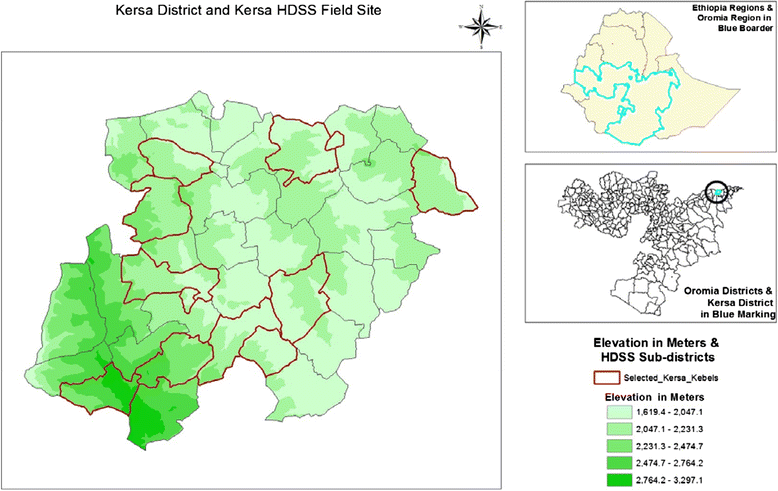
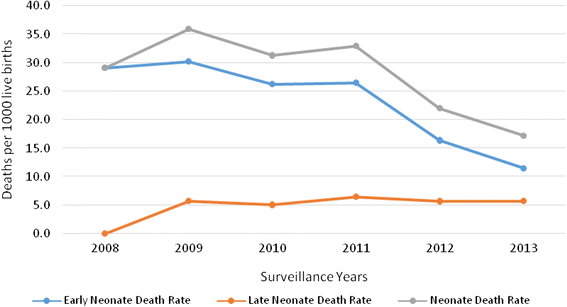
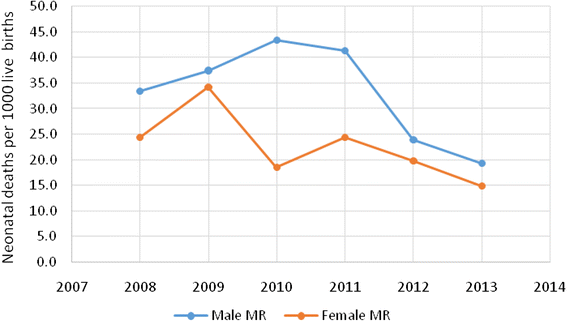
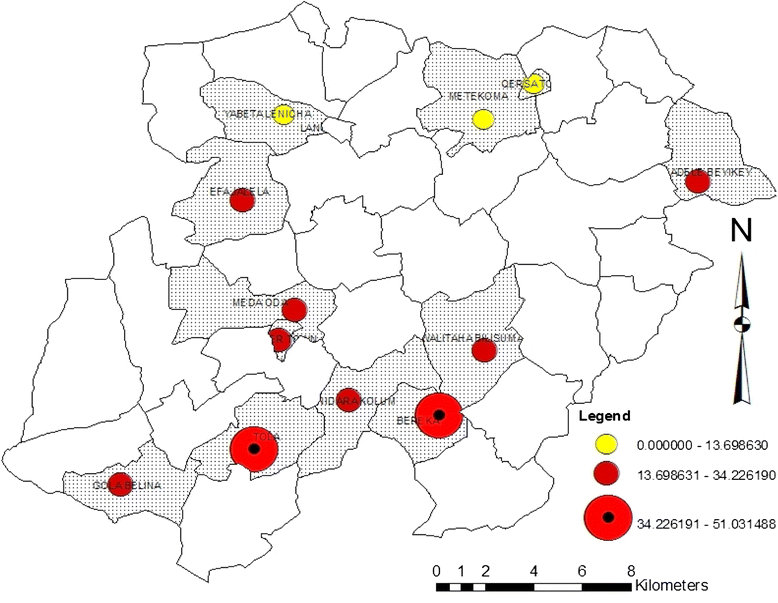
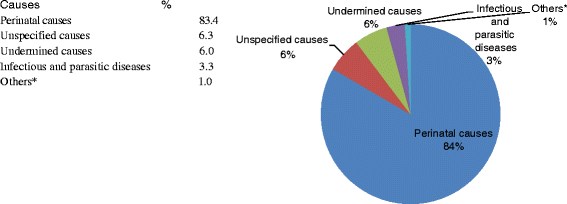
Similar articles
-
Trend and causes of adult mortality in Kersa health and demographic surveillance system (Kersa HDSS), eastern Ethiopia: verbal autopsy method.Popul Health Metr. 2017 Jul 1;15(1):22. doi: 10.1186/s12963-017-0144-2. Popul Health Metr. 2017. PMID: 28666480 Free PMC article.
-
Causes of Death among Children Aged 5 to 14 Years Old from 2008 to 2013 in Kersa Health and Demographic Surveillance System (Kersa HDSS), Ethiopia.PLoS One. 2016 Jun 15;11(6):e0151929. doi: 10.1371/journal.pone.0151929. eCollection 2016. PLoS One. 2016. PMID: 27304832 Free PMC article.
-
Why mothers die: Analysis of verbal autopsy data from Kersa Health and Demographic Surveillance System, Eastern Ethiopia.J Glob Health. 2022 Jul 22;12:04051. doi: 10.7189/jogh.12.04051. J Glob Health. 2022. PMID: 35976002 Free PMC article.
-
HDSS Profile: The Kersa Health and Demographic Surveillance System.Int J Epidemiol. 2016 Feb;45(1):94-101. doi: 10.1093/ije/dyv284. Epub 2015 Oct 27. Int J Epidemiol. 2016. PMID: 26510420 Free PMC article.
-
An Audit of Mortality Pattern in the Neonatology Unit of the University of Uyo Teaching Hospital, Uyo, Nigeria: A Seven-Year Review.Niger Med J. 2024 May 23;65(2):213-221. doi: 10.60787/nmj-v65i2-410. eCollection 2024 Mar-Apr. Niger Med J. 2024. PMID: 39005554 Free PMC article. Review.
Cited by
-
Neonatal mortality among neonates admitted to NICU of Hiwot Fana specialized university hospital, eastern Ethiopia, 2020: a cross-sectional study design.BMC Pediatr. 2021 Mar 15;21(1):125. doi: 10.1186/s12887-021-02598-z. BMC Pediatr. 2021. PMID: 33722200 Free PMC article.
-
Uncertainties in the path to 2030: Increasing trends of under-five mortality in the aftermath of Millennium Development Goal in Eastern Ethiopia.J Glob Health. 2022 Jan 22;12:04010. doi: 10.7189/jogh.12.04010. eCollection 2022. J Glob Health. 2022. PMID: 35136601 Free PMC article.
-
Maternal and neonatal data collection systems in low- and middle-income countries for maternal vaccines active safety surveillance systems: A scoping review.BMC Pregnancy Childbirth. 2021 Mar 17;21(1):217. doi: 10.1186/s12884-021-03686-9. BMC Pregnancy Childbirth. 2021. PMID: 33731029 Free PMC article.
-
Determinants of neonatal mortality in Ethiopia: an analysis of the 2016 Ethiopia Demographic and Health Survey.Afr Health Sci. 2020 Jun;20(2):715-723. doi: 10.4314/ahs.v20i2.23. Afr Health Sci. 2020. PMID: 33163036 Free PMC article.
-
Association of drinking water and environmental sanitation with diarrhea among under-five children: Evidence from Kersa demographic and health surveillance site, eastern Ethiopia.Front Public Health. 2022 Nov 14;10:962108. doi: 10.3389/fpubh.2022.962108. eCollection 2022. Front Public Health. 2022. PMID: 36452955 Free PMC article.
References
-
- Rafael L, Haidong W, Kyle JF, Julie KR, Mohsen N, Jake RM, Laura D, Katherine TL, David P, Charles A, et al. Progress towards Millennium Development Goals 4 and 5 on maternal and child mortality: an updated systematic analysis. Lancet. 2011;378:1139–1165. doi: 10.1016/S0140-6736(11)61337-8. - DOI - PubMed
-
- Lawn JE, et al. Health Policy Plan. Lancet. 2012;79(9832):2151–2161. - PubMed
-
- UNICEF, WHO, Worldbank, UNFPA . Levels and trends in child mortality report 2012. New York: UNICEF; 2013.
-
- UNICEF, WHO, Worldbank, UNFPA . Levels and trends in child mortality report 2013. New York: UNICEF, WHO, Worldbank, and UNFPA; 2014.
-
- Liv L, Jonson H, Cousens S, et al. Global, regnal and national causes of child mortality: updated system analysis. 2012.
LinkOut - more resources
Full Text Sources
Other Literature Sources

